but just to add a bit of confusion, Decauville's name for their road car of this type was "Voiturelle"
Wasn't that because Léon Bolée claimed copyright over voiturette?
interesting that the Decauville has independent front suspension.
Posted 23 January 2020 - 09:44
but just to add a bit of confusion, Decauville's name for their road car of this type was "Voiturelle"
Wasn't that because Léon Bolée claimed copyright over voiturette?
interesting that the Decauville has independent front suspension.
Advertisement
Posted 23 January 2020 - 10:03
interesting that the Decauville has independent front suspension.
but what you can't see is that the rear axle was mounted on the chassis - i.e. no rear suspension.
A bit like this:
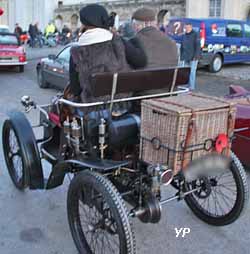
Posted 24 January 2020 - 10:44
Léonce Girardot and his Léon Bollée voiturette. In racing trim, the Bollée was good for 60 km/h on the level, and up to 90 km/h on long descents.
(a "typogravure Goupil" published in Les Sports Modernes, 1898)
The Léon Bollée three-wheeler was the first of all voiturettes. It appeared on the boulevards in Paris by the end of April 1896.
The name "voiturette" came up when Pierre Giffard described the Bollée on the front page of the Petit Journal on Sunday, 3 May 1896:
https://gallica.bnf....t6k613876f.item
= = = =
Pierre Giffard was sports editor of the Petit Journal and one of the organisers of the 1894 concours from Paris to Rouen. The Petit Journal was owned by Hippolyte Marinoni, the inventor of the rotary printing press, and had a circulation of one million per day. A description on the front page of a Sunday issue was the best possible publicity for Bollée's three-wheeler.
Giffard in 1899:
(photos Jules Beau collection)
= = = =
Thursday, 28 April 1898:
Léon Bollée after winning the Critérium des Motocycles (distance 100 km, from Étampes to Chartres and back) in 1 h 57 min 2 sec
(motocycle = bi-, tri- or quadricycle with a maximum weight of 200 kilograms):
Later, Bollée was disqualified, his three-wheeled voiturette being found overweight by 20 kilograms.
Posted 24 January 2020 - 20:48
Posted 25 January 2020 - 12:14
The drivers who handled the three Brasiers in the 1905 French Bennett elimination through the Auvergne, Théry, Caillois and Stead, did not start in the first Grand Prix. In June 1906 on the Circuit de la Sarthe, the three Brasiers were driven by Baras, Barillier and Pierry.
After the Grand Prix, Pierry became known as the "chauffeur masqué et démasqué". Pierry's real name was Pierre Huguet, and he was involved in a caoutchouc plantation somewhere in Brazil. Pierry drove a Brasier in the 1906 Grand Prix and in the Circuit des Ardennes.
In the 1890s, Huguet had been a well-known bicycle star under his first nom de course "Gaby". In November 1893, at the Vélodrome de la Seine (located not far away from the Seine at Levallois-Perret, Rue de Courcelles), Gaby rode a tandem with Henry Fournier against Buffalo Bill Cody who was allowed six horses (Cody and his horse used the grass track inside the vélodrome - one lap for the tandem was 500 metres; one lap for the horse 481 metres). The match lasted a total of six hours. The tandem won, covering 178 kilometres to 173 for Cody's horses.
On Thursday, 27 June 1901, Pierre Huguet started under his real name Huguet in the race from Paris to Berlin at the wheel of No. 35 Otto (the Otto was built in Paris by the "Société de Moteurs à Gaz et d'Industrie Automobile" :
(photo Jules Beau collection)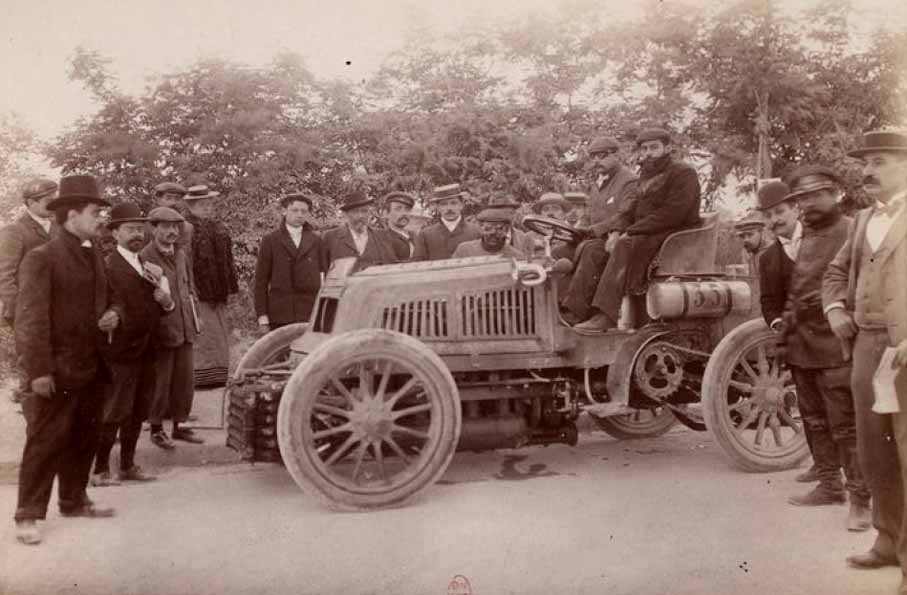
Edited by robert dick, 25 January 2020 - 12:17.
Posted 29 January 2020 - 10:54
Posted 30 January 2020 - 12:11
Decauville in May 1900 - seven pages in La Vie au Grand Air - beginning at
https://gallica.bnf....06058b/f5.image
... up to
https://gallica.bnf....6058b/f11.image
Posted 01 February 2020 - 10:17
Start of the 1901 Paris-Berlin was on the plateau de Champigny (15 kilometres east of the Place de la Concorde - in 1902 the Circuit du Nord and the Paris-Vienna were also started from Champigny). "The attention of the whole world has been attracted to the performances of the automobiles in the race which started on June 27 from Paris for Berlin, arriving in that city on the 29th. The start was made at 3:30 in the morning. The road to Champigny was lined with thousands of spectators, on foot, on cycles and in motor cars." (photos Jules Beau collection)
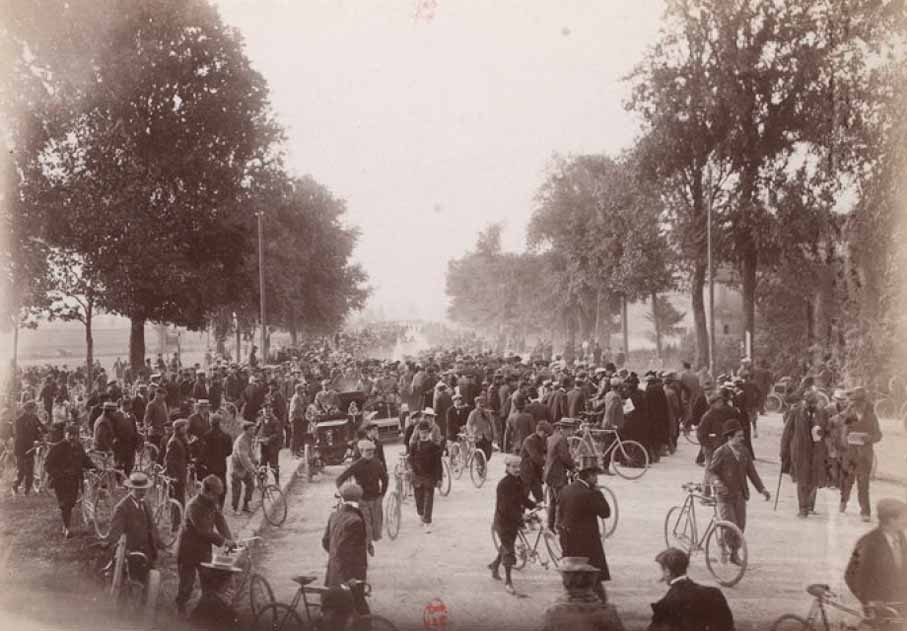
= = = =
Thursday, 27 June 1901, a few minutes before 3:30 in the early morning. The first starter in the 1901 Paris-Berlin was Étienne Giraud with his 650-kg Panhard. The voiture légère or light car class with a maximum weight of 650 kilograms was introduced by the beginning of the 1901 season. The weight of the big cars was not restricted up to 1902.
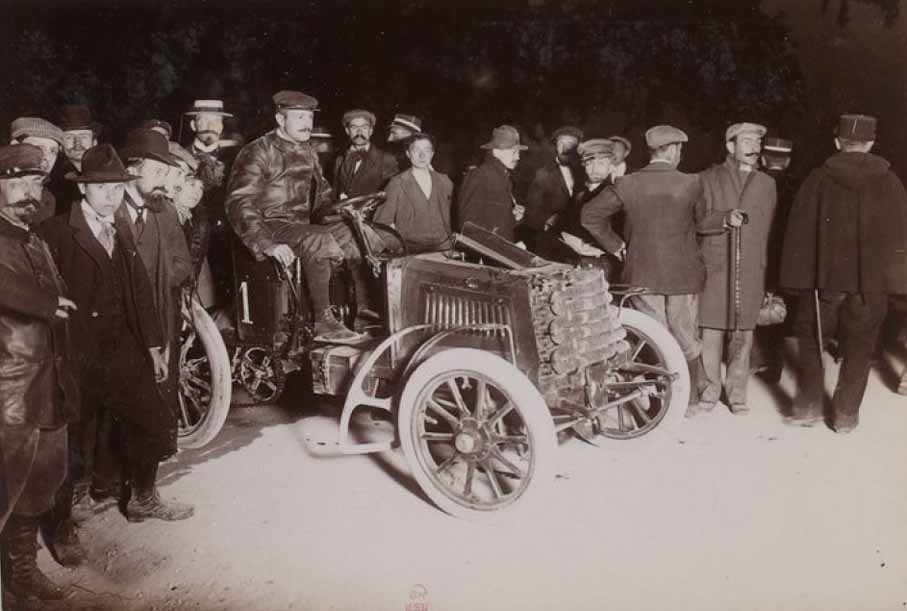
= = = =
The other competitors followed in two-minute intervals. The second starter was Georges Huillier with his 10-litre Mors. Huillier started as usual under his nom de course "Gilles Hourgières". He was a lawyer, a member of the ACF's commission sportive and a director at the Société d'Électricité et d'Automobiles Mors. He was also the inventor of the tonneau body. The photo was taken a few days before the start, during the technical control in the backyard of the ACF's hôtel Pastoret, Place de la Concorde.

Advertisement
Posted 01 February 2020 - 10:46
Posted 01 February 2020 - 18:46
The spelling - Hourgières or Hourgière - was and is unclear. In L'Auto or the contemporary trade press it was 90% "Hourgières" and 10% "Hourgière". For Pierre Souvestre in his Histoire de l'Automobile published in 1907 it was "Hourgières". However, La Vie au Grand Air published an article written by Huillier about the 1900 Paris-Toulouse race in which it was "Hourgière" without the final "s".

Nom de course examples:
Levegh = Alfred Velghe; Pierre Huguet = Pierry; Dr. Pascal = Henri de Rothschild; André Axt = André Hachette; Antony = Henri Debray; or Augières = Georges Auger. In all these cases, the reason for the nom de course was the family and/or the business. And in all cases, for a member of the Tout-Paris it was "de bon ton" to start "sous un pseudonyme".
Posted 04 February 2020 - 10:44
In 1902 the Gaillon hillclimb (between Paris and Rouen) was held on two weekends. On Sunday, 21 September 1902, Hubert Le Blon with his wife as riding mécanicienne started in a stripped Gardner-Serpollet steamer and achieved 40 4/5 seconds over the flying kilometer with an average gradient of nine percent. (photos Jules Beau collection and La Vie au Grand Air/Bibliothèque Nationale/Paris)

= = = =
Three weeks later, on Sunday, 12 October, the world's fastest couple appeared in a streamlined Serpollet and achieved 36 seconds flat.

Posted 04 February 2020 - 14:15
Regardez l'aile!!!
Posted 06 February 2020 - 17:08
On Tuesday, 26 August 1902, Levegh drove a 9.2-litre Mors in the sprint meeting at Deauville. He covered the flying kilometre in 28 seconds. It was Levegh's last appearance in competition. (photos Jules Beau collection)
= = = =
Paul Chauchard in his 13.6-litre Panhard covered the kilometre in 26 3/5 seconds. As vice-president of the Auto-Vélo Club de Nice, Chauchard was one of the animating spirits behind the Riviera meeting. He had been the owner of one of the first Léon Bollée voiturettes.
A year before Deauville, during the first stage of the 1901 Paris-Berlin, Chauchard was "reported to have been the victim of a cruel joke at Sedan. In great haste he called for 'essence' at a shop where the all-needful motor fuel was advertised for sale. Either by error, or in the spirit of a joke, the 'garçon' promptly supplied him with a can of water, and the difference between oil and water was not discovered until the fuel positively refused to ignite."
= = = =
Paul Ribeyrolles in his Darracq achieved 32 4/5 seconds. Ribeyrolles was a technical director at Darracq. He was the Keith Duckworth of the heroic age. Ribeyrolles had obtained his engineering degree at the famous École des Arts et Métiers of Châlons. In 1903, Ribeyrolles introduced the L-head for the 650-kg Darracq and in 1905 the OHV-head for the 1000-kg racer.
Posted 06 February 2020 - 21:02
I don’t know whether this has been posted before, but in case it hasn’t here is a short movie from a mere one hundred and sixteen years ago:
https://www.filmport...orennen-1761904
Sorry to interrupt, this is a most wonderful thread!
Posted 07 February 2020 - 15:29
This era of motor sport, whether it was on either side of the Atlantic World, so often tends to overlooked, romanticized, ignored, rendered hopelessly nostalgic, and dismissed. In large part, I must thank Robert for helping convert what began as an interest brought about by curiosity into an almost overwhelming research compulsion. While the majority of my attention is focused on the western side of the Atlantic World, one cannot even begin to do so without paying great attention to the goings-on taking place on the Eastern side. With the material so necessary for researching this era becoming more accessible, the more interesting and fascinating it has become.
Posted 08 February 2020 - 17:25
Léon Théry and No. 5 Richard-Brasier winning the 1904 French Bennett elimination on the Circuit de l'Argonne (60 kilometres northwest of Reims). A few weeks later, during the main race, the press described Théry as "the fat, good natured, 220-pound, 25-year-old Thery, favorite of France and all but favorite of the wise ones of the whole motor racing world". (photos Jules Beau collection)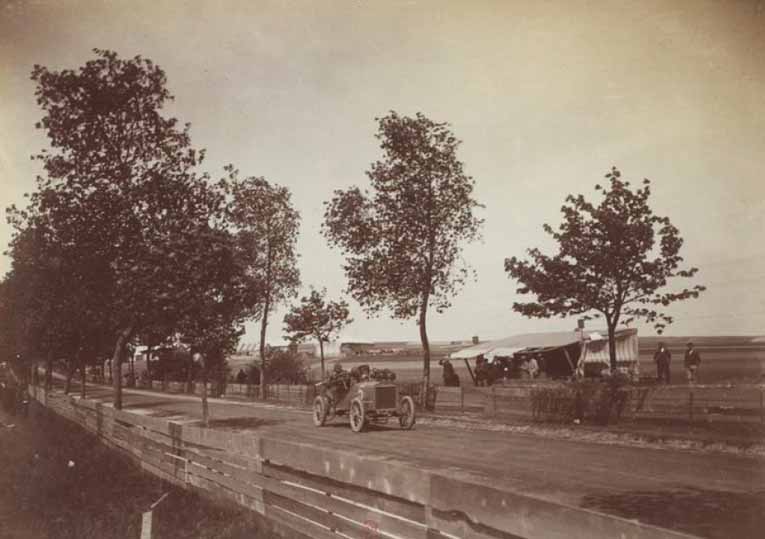
= = = =
The direct forerunner of Théry's Richard-Brasier in which he won the French Bennett elimination and the main race in 1904 was the Richard-Brasier 650-kg light car used in the Fall of 1903 in several sprint races.
On Sunday, 8 November 1903, Henri Brasier and Jean Denjean had the intention to start in the Gaillon hillclimb. Denjean was a foreman of the Richard-Brasier shops at Ivry, the practical mind and éminence grise behind Brasier. Denjean and Brasier tested their 650-kg racers during the early morning of Sunday, despite thick fog. When trying to avoid a collision, Denjean turned over. He died of his injuries a few hours after the accident, mechanic Edmond Chocholle on 13 November (depending on the reports the names were spelled Denjean, Danjean or Danjan; Chocholle, Chaucholles or Chauchol).
Jean Denjean and the 650-kg Richard-Brasier during the "pesage", the scrutineering and weight control at Vernon, 10 kilometres southeast of Gaillon, Saturday, 7 November 1903: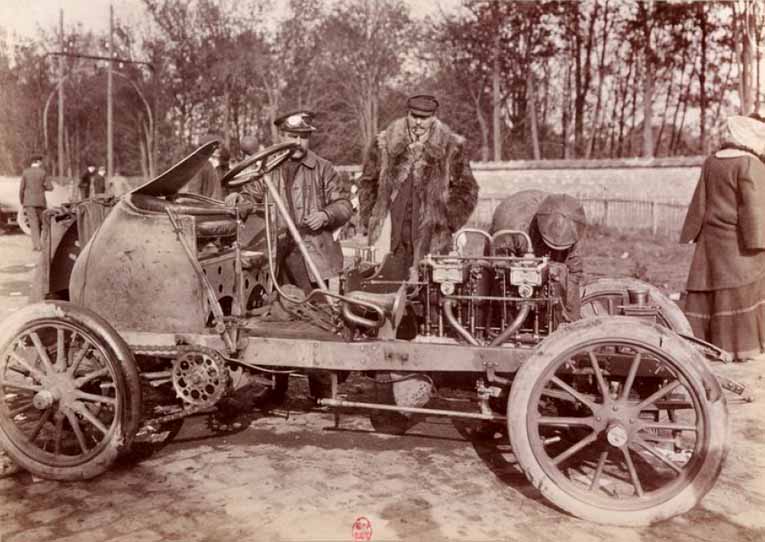


Posted 08 February 2020 - 20:39
Wonderful photos, thanks for posting these for us to enjoy.
It is interesting that the organisers of the 1904 French Bennett elimination on the Circuit de l'Argonne were concerned with crowd safety by erecting wooden 'armco' seemingly along both sides of the endless straights. But why put it behind the trees? I guess they were not too concerned about the participants who knew the risks.
Posted 09 February 2020 - 00:10
The purpose is probably to keep the spectators off track...
Posted 09 February 2020 - 09:01
Quick query on Albert Lemaître, who got away with murdering his wife in 1906 on the basis that the French do not think crimes of passion are crimes.
What happened to him afterwards? I can't find any trace of him in history post this.
Posted 09 February 2020 - 18:03
According to this article - from Le Petit Journal/Paris, Friday, 7 September 1906 - Lemaître also shoot himself in the head. He survived but was almost blind.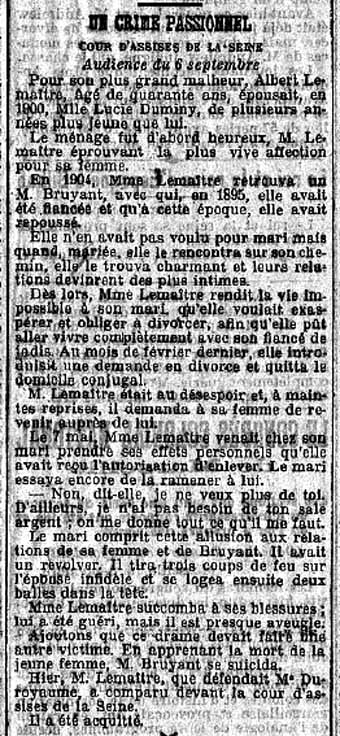
= = = =
Spring 1899: Lemaître with Armand Peugeot as passenger in/on the Peugeot (rear engine, 5.85-litre twin, 140 x 190 mm) which was successful in the 1899 Riviera meeting. Lemaître won the road race between Nice and Castellane, the hillclimb up to La Turbie and the kilometre sprint on the Promenade des Anglais. (photo Les Sports Modernes)
Not sure whether it was the same/our Albert Lemaître who in 1904 was president and consulting engineer of the American De Dietrich Motor Car Co. which was the De Dietrich importer with offices opposite the Waldorf-Astoria in Manhattan.
Posted 09 February 2020 - 19:11
Posted 09 February 2020 - 19:13
Our Albert was a champagne exporter, in business with his brother. He recovered enough to be put on trial three months after the murder of his poor Mrs.
Posted 10 February 2020 - 09:04
Concerning the fences on the Circuit de l'Argonne, French Bennett elimination, May 1904: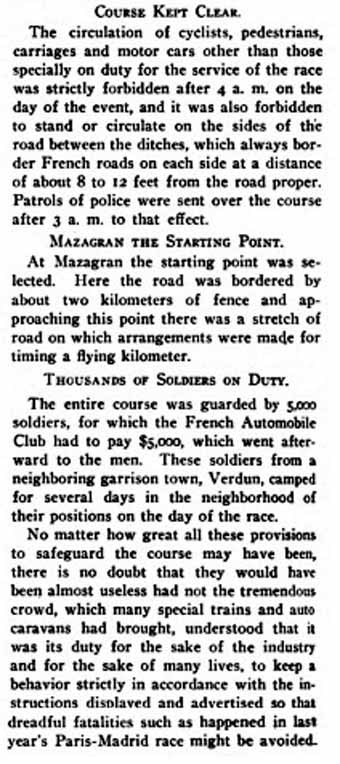
Posted 11 February 2020 - 10:30
Addition to Huillier/Hourgière(s) - his windshield system exhibited at the Paris Salon in December 1906:
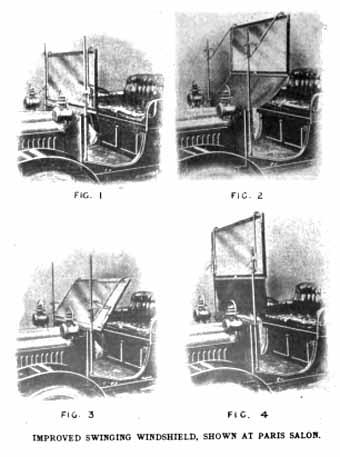
Posted 14 February 2020 - 11:46
Saturday, 7 November 1903, scrutineering for the Gaillon hillclimb: Louis Rigolly and his 13.5-litre Gobron-Brillié or "Gobbling Billy".
On Sunday, Rigolly made fastest time of the day, covering the flying uphill kilometre in 33 3/5 seconds. Rigolly was "chef de service technique" of the Gobron factory at Boulogne-sur-Seine. Features of the 13.5-litre Gobron were a four-cylinder with two opposed pistons per cylinder (bore = 140 mm, stroke = 2 x 110 mm) and a frame made of tubes. A few months after Gaillon, in March 1904 on the Promenade des Anglais at Nice, Rigolly and the Gobron covered a flying kilometre in 23 3/5 seconds, 152.5 kilometres per hour. (photos Jules Beau collection)
= = = =
Paul Faure, "le gros et populaire Faure", and his 13.6-litre Panhard achieved 43 seconds in the 1903 Gaillon hillclimb. Faure was garagiste at 79 Boulevard Gouvion-Saint Cyr near the Porte Maillot, Paris. He was also known as "médecin automobile". In 1904 he prepared Francis Terry's Mercedes in view of the Circuit des Ardennes and in 1905 Pierre de Caters' Mercedes in view of the Bennett Cup.
Posted 14 February 2020 - 13:47
The Gobron-Brillié tubular chassis must have been a rarity at that time; it hardly looks strong enough but I assume lighter than the more traditional ladder frame. 153kph is quite impressive.
Posted 14 February 2020 - 14:25
While we are on the Heroic Age, has anyone a pic of the Dufaux-Marchand in Grand Prix fettle? That's one that TASO Mathieson's book missed.
Posted 14 February 2020 - 15:02
Indeed it would be good to see. Robert Dick posted pictures of the 1904 Dufaux on the "Straight eight crankshafts" thread, and presumably the 1907 engine was the same configuration, given that Rose notes it as an 8 cylinder.
Advertisement
Posted 14 February 2020 - 15:41
There's one in the Cimarosti book too, but it looks like it's in road-test form.
Posted 15 February 2020 - 15:22
While we are on the Heroic Age, has anyone a pic of the Dufaux-Marchand in Grand Prix fettle? That's one that TASO Mathieson's book missed.
You may have already seen this but in case you have not there is a youtube film of the Dieppe GP's 1907 - 1908 and 1012.
The first half are stills but from 15.30mins in there is movie film which I think comes from the Bill Mason Shell series. At 16.40 into the youtube clip you will see footage of the 1907 GP with car number DM1 on the rad (which is the Dufaux Marchand car) . It has nearly lost it, running very wide, and needs a push back to start it again. Not a very clear image but does show the car as it raced.
https://youtu.be/D-m1QPhu1Pc?t=1000
Posted 15 February 2020 - 16:34
The Dufaux-Marchand of the 1907 GP de l'ACF (14.7-litre, 125 x 150 mm) was the slightly updated straight-eight Dufaux of 1904.
The car used by Frédéric Dufaux on 13 November 1905 for his record trials between Arles and Salon was a 26.4-litre four-cylinder (225 x 166 mm).
Posted 16 February 2020 - 10:07
Gaillon scutineering, 7 November 1903:
Louis Wagner and his Darracq won the 400-kg voiturette class of the 1903 Gaillon hillclimb in 40 seconds flat (four 1000-kg cars and one 650-kg car were faster). The Darracq was powered by a 3.75-litre four-cylinder L-head (100 x 120 mm). (photos Jules Beau collection)
= = = =
Paul Tavenaux and his Passy-Thellier finished second in the voiturette class with 58 1/5 seconds, far away from Wagner and the Darracq. The Passy-Thellier was powered by a two-cylinder Gobron engine. Tavenaux had the intention to drive a Grégoire in the 1906 GP de l'ACF at Le Mans but was unable to start because of a cracked cylinder.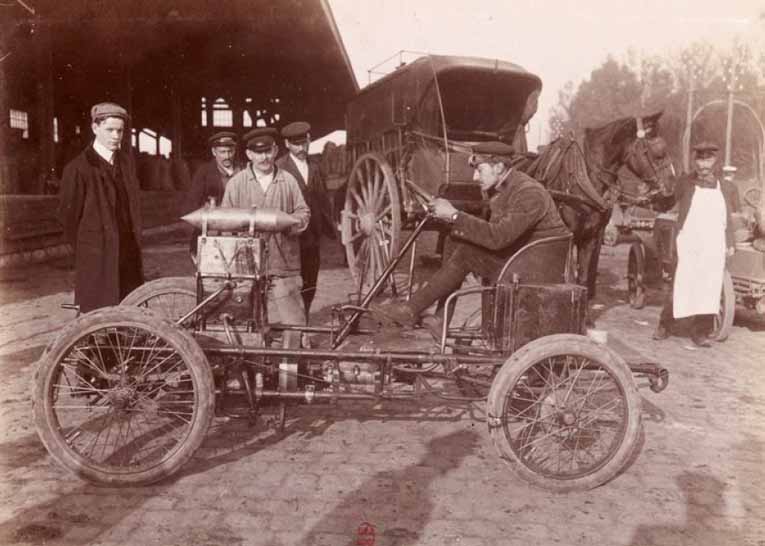
= = = =
Louis Wagner - the photo (from the Detroit Public Library) was taken in October 1906 in Manhattan in front of the American Darracq branch, after Wagner's victory in the Vanderbilt Cup. Wagner had certainly one of the most interesting and successful careers of all times.
In June 1947, Peter Helck wrote to Louis Wagner: "The last time I saw you was when I was a thirteen year youngster. You had just won the Vanderbilt Cup an hour before, and in celebrating your grand victory you dashed through the village of Roslyn. I heard your exhaust, rushed to the front of the house, and waved to the flying, blue Darracq... and the great Louis Wagner returned my salute!!!" 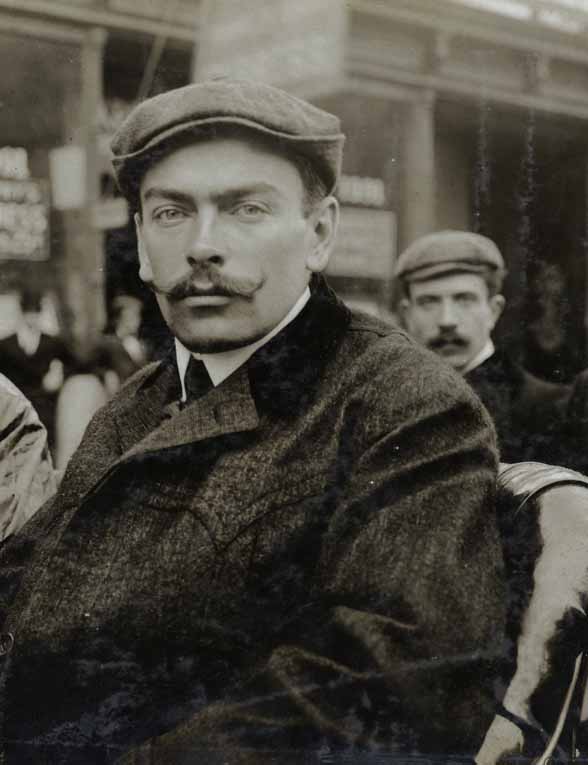
Posted 20 February 2020 - 17:02
Edward T. Stead started in the 1904 and -05 French Bennett eliminations as member of the Brasier team. He lived in London, Fulham, Radipole Road.
In April 1902, in the Riviera meeting, Stead drove a 6.5-litre Mercedes (strictly a Simplex). Stead achieved best time in the 17-km hillclimb up to La Turbie in 16 min 37 sec. The photo was taken on the Promenade des Anglais at Nice. (photos Jules Beau collection)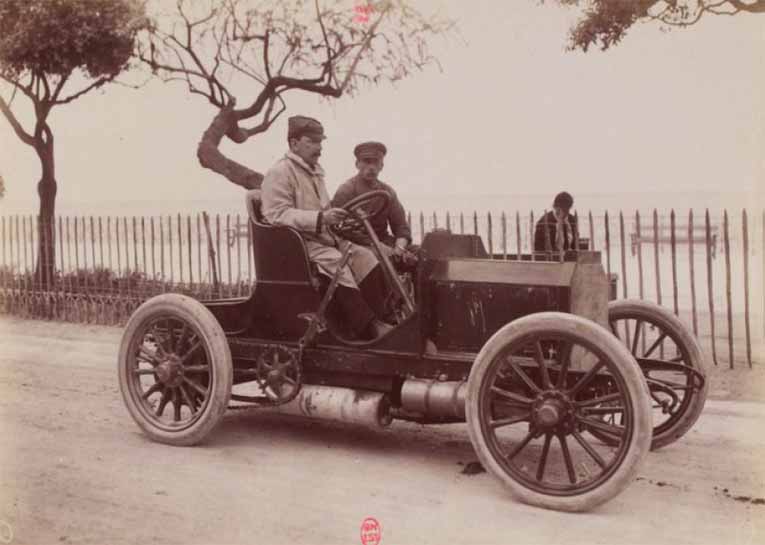
= = = =
A few weeks later, in the race from Paris to Vienna, Stead drove a 650-kg Georges Richard in the voiture légère class. The photo was taken before the race in the Rue de Rivoli near the ACF's Hôtel Pastoret.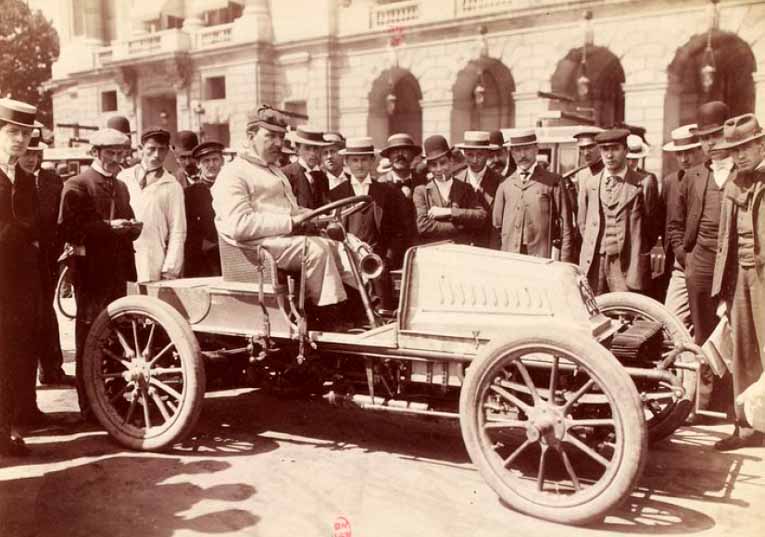
Posted 22 February 2020 - 17:26
= = = =
Louis Wagner - the photo (from the Detroit Public Library) was taken in October 1906 in Manhattan in front of the American Darracq branch, after Wagner's victory in the Vanderbilt Cup. Wagner had certainly one of the most interesting and successful careers of all times.
In June 1947, Peter Helck wrote to Louis Wagner: "The last time I saw you was when I was a thirteen year youngster. You had just won the Vanderbilt Cup an hour before, and in celebrating your grand victory you dashed through the village of Roslyn. I heard your exhaust, rushed to the front of the house, and waved to the flying, blue Darracq... and the great Louis Wagner returned my salute!!!"
Does anyone know if a biography of Louis Wagner has ever been published?
He raced for some 20 years or so and seems to have driven a wide variety of cars both sides of the Atlantic.
Posted 23 February 2020 - 18:01
AFAIK no Louis Wagner biography has been published in book form.
= = = =
Wagner with wife and daughter, after finishing second at the wheel of a 4,5-litre Mercedes in the 1914 GP de l'ACF, Lyon (photo Meurisse collection, Bibliothèque Nationale, Paris).
= = = =
Wagner near the 2-litre V12 Delage, 1926 San Sebastian (photo Rol collection, Bibliothèque Nationale, Paris).
Posted 26 February 2020 - 19:00
The Circuit du Nord à l'Alcool (the fuel had to contain at least fifty percent of alcohol) was held on Thursday and Friday, 15 and 16 May 1902. The first stage was from the fourche de Champigny/Paris to Arras (383 km), the second stage from Arras via Boulogne-sur-Mer and Dieppe back to Saint-Germain/Paris (482 km). It was the first road race held under the 1000-kg limit.
Maurice Farman and his 1000-kg Panhard won in 12 h 1 min 52 sec, 72 km/h. The Panhard was a 1901 racer, an older 7,4-litre slightly updated in view of the Nice-Abbazia race which had been called off a few weeks before. (photos Jules Beau collection)
= = = =
Henri Farman (Maurice's brother) drove a 650-kg Panhard and finished second in the voiture légère class (fourth overall).
= = = =
Georges Grus drove a 400-kg Renault and won the voiturette class (sixth overall). Grus was manager of the Grus, Cabarrus & Cie., a Renault agency at Boulevard Malesherbes, Paris.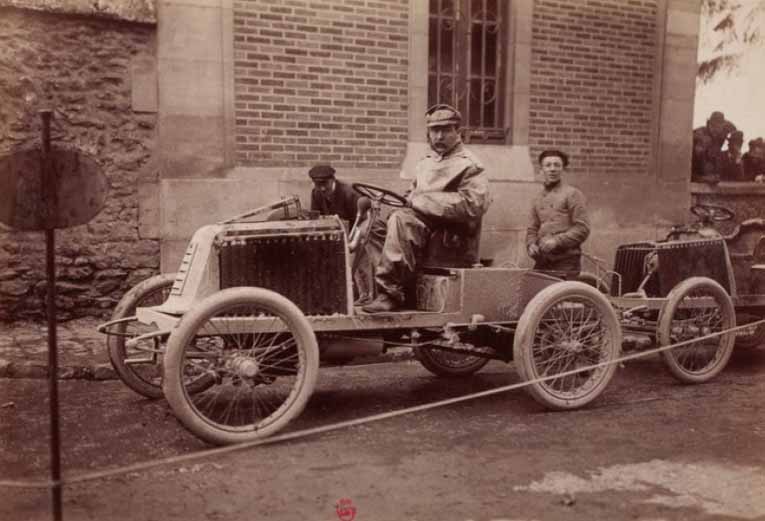
Posted 01 March 2020 - 10:18
Addition concerning Grus:
Georges-Félix Grus was born in Saint-Cloud, Paris, on 20 June 1873. With Louis Cabarrus, he managed the Grus, Cabarrus & Cie. which ran Renault agencies in Paris, Marseille and Nice. Grus married Magdeleine Boulanger on 23 January 1907. His sudden death (at home, 6 Avenue Marceau, Paris) was announced in the daily press of 27 December 1920.
In the 1903 Paris-Madrid, Grus drove a 650-kg Renault. The photo was taken on Wednesday, 20 May 1903, during the pesage/scrutineering in the Jardin des Tuileries which was more or less the front garden of the ACF's Hôtel Pastoret. Weight was 643 kilograms. On race day, Sunday, 24 May, Grus was timed by the control at Poitiers but not by the following control at Ruffec. Probably he stopped at Couhé-Vérac (between Poitiers and Ruffec) where Marcel Renault (who started one hour before Grus - starts in one-minute intervals) had his accident. (photo Jules Beau collection)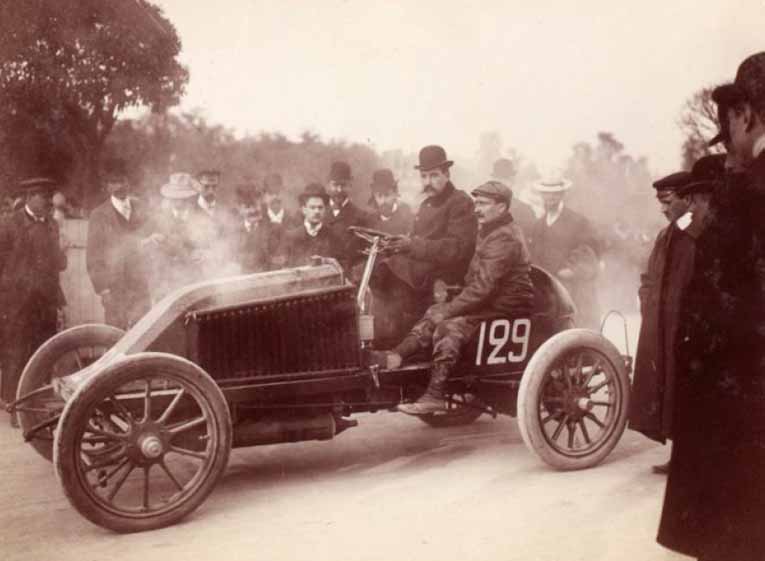
= = = =
Achille Fournier drove an 11.5-liter Mors in the 1903 Paris-Madrid, a "dauphin type Paris-Madrid". (Three Fournier brothers: Achille born in Le Mans on 6 February 1868; the famous Henry on 13 April 1871; and Maurice on 30 December 1880).
Posted 01 March 2020 - 13:22
Love the aerodynamics on the Mors...
Posted 01 March 2020 - 21:24
What a wonderful thread this has become... ![]()
DCN
Posted 04 March 2020 - 17:08
Four Aders ready for the 1903 Paris-Madrid, in front of the Ader factory, 98 Rue Cormeilles, Levallois-Perret, Paris.
Three 400-kg voiturettes: No. 130 with Birnbaum, No. 73 with d'Aubignosc, in the background No. 140 with Sommier; and a 650-kg voiture légère: No. 16 with Valentin. The Ader was built by the automobile branch of the "Société Industrielle des Téléphones". The 400-kg voiturette was powered by a 90-degree V4 of 1,8 litres, the 650-kg light car by two V4s in tandem, a 3.6-litre V8. All four cars arrived in Bordeaux.
The original Delage shops were located in the same Rue Cormeilles, Levallois. And during WW1, former Peugeot designer Ernest Henry had his own independent drawing office and shop in the Rue Cormeilles.
(photos Jules Beau collection)
= = = =
Francis Terry started in the Paris-Madrid at the wheel of his 9.25-litre Mercedes. Terry was the son of the Cuban sugar king Francesco Terry who was the owner of the Château de Chenonceau between 1891 and 1913. Terry left the road near Coignières when trying to pass Leslie Porter's Wolseley. The Mercedes caught fire and burned out.
A few weeks after the Paris-Madrid, a similar 9.25-litre driven by Jenatzy won the Bennett Cup in Ireland.
Posted 05 March 2020 - 08:07
I'm continually amazed by the quality of these pictures.
Posted 05 March 2020 - 09:31
Edited by bradbury west, 05 March 2020 - 10:43.
Posted 05 March 2020 - 10:01
That they have survived is also a great thing...
Once glass plate negatives lost favour they were often consigned to very dusty holes in walls, lost because nobody was interested in working with them and then everyone connected with them died.
At Gundagai in NSW there was a doctor who was an avid photographer using them from about 1890 to 1924. The fell into disuse, likely to be lost forever. Until a couple of people in the town who were just children when the doctor was around decided to save them. Possibly the launching of the Canberra-based Australian Film and Sound Archive was the key to this, and the glass plates were recovered from under the doctor's old home and sent to Canberra for restoration.
There are many great prints of these photos in the various stores and other places around town, including McDonalds, because these people cared. And a very large display of them in a big room above a hardware store in the main street.
Posted 05 March 2020 - 10:15
. . . recovered from under the doctor's old home . . .
That's where having houses with clear space below comes into its own! Here in Europe houses are built on the ground, so lack the extra storage for unwanted junk that's common in Oz, so more stuff gets thrown out.
Glass plates are fragile and heavy which doesn't help them survive. I expect the first generation of film negatives are just as uncommon, but at least they were big enough that contact prints can be easily seen and understood, unlike the 35mm of later times.
Posted 05 March 2020 - 12:47
Oscar Bell (no relation) was the one who knew of the location of those plates...
I learned all of this as I breezed around the display above the hardware store. The other party, whose name I either never knew or have forgotten, was there at the time, as was a woman doing some bookwork. I went up to this bloke as I looked and told him what I had noted about the doctor's framing of a lot of photos.
"I do perceive," I said, "that the good doctor had an eye for the ladies." Many photos had young ladies in the foreground no matter whether the subject was a flood across the new bridge or anything else. This bloke said nothing.
A little while later, the lady took her books down the stairs and we were left alone. He sidled up to me and said, "Old Oscar told me once that when he was about eight or ten he had a medical problem and the doctor wanted him to go to the hospital in Wagga. He was going over there too, and so was the Matron from the Gundagai hospital."
So here we have a picture of the doctor driving the sulky, the young patient on board and the matron as well. It was about fifty miles. "Out on the flats near Nangus," he continued, "the doctor pulled up the sulky on a bridge and the matron climbed down onto the bridge, the doctor handed Oscar the reins and instructed him, 'You hold onto the horses, boy, the matron and I have to inspect something under the bridge!'"
Posted 05 March 2020 - 21:42
Many unwanted and unvalued glass plate negs ended up being used as cut-price cloche and greenhouse glazing... sun, rain and weathering progressively erasing the covering emulsion and the images recorded within it...
DCN
Posted 05 March 2020 - 22:02
Posted 05 March 2020 - 23:03
I heard that too...
Very sad, especially seeing as they would have been an expensive thing to deal with originally.
Advertisement
Posted 06 March 2020 - 15:58
It seems a miracle that any of these European glass plates survived two WW .